Sociology Essay on Changing Business Scenario: Labour Market
VerifiedAdded on 2023/01/18
|8
|2139
|87
Essay
AI Summary
This essay examines the declining demand for low-skilled labor in developed countries, attributing it to technological advancements, globalization, and automation. It explores wage inequality, unemployment rates, and the impact of these factors on the labor market. The analysis considers case studies of the United Kingdom, United States, and France, highlighting how technological progress and trade dynamics have reshaped employment opportunities. The essay also discusses the polarization of the labor market, the impact of immigration, and the role of policies in addressing skill gaps and promoting workforce development. The influence of technology on the workforce, the rise of high-skilled workers, and the challenges faced by low-skilled workers in adapting to the changing economic landscape are all discussed. Furthermore, the essay presents the importance of education and training programs to help the low-skilled workers to adapt to the new business trends.
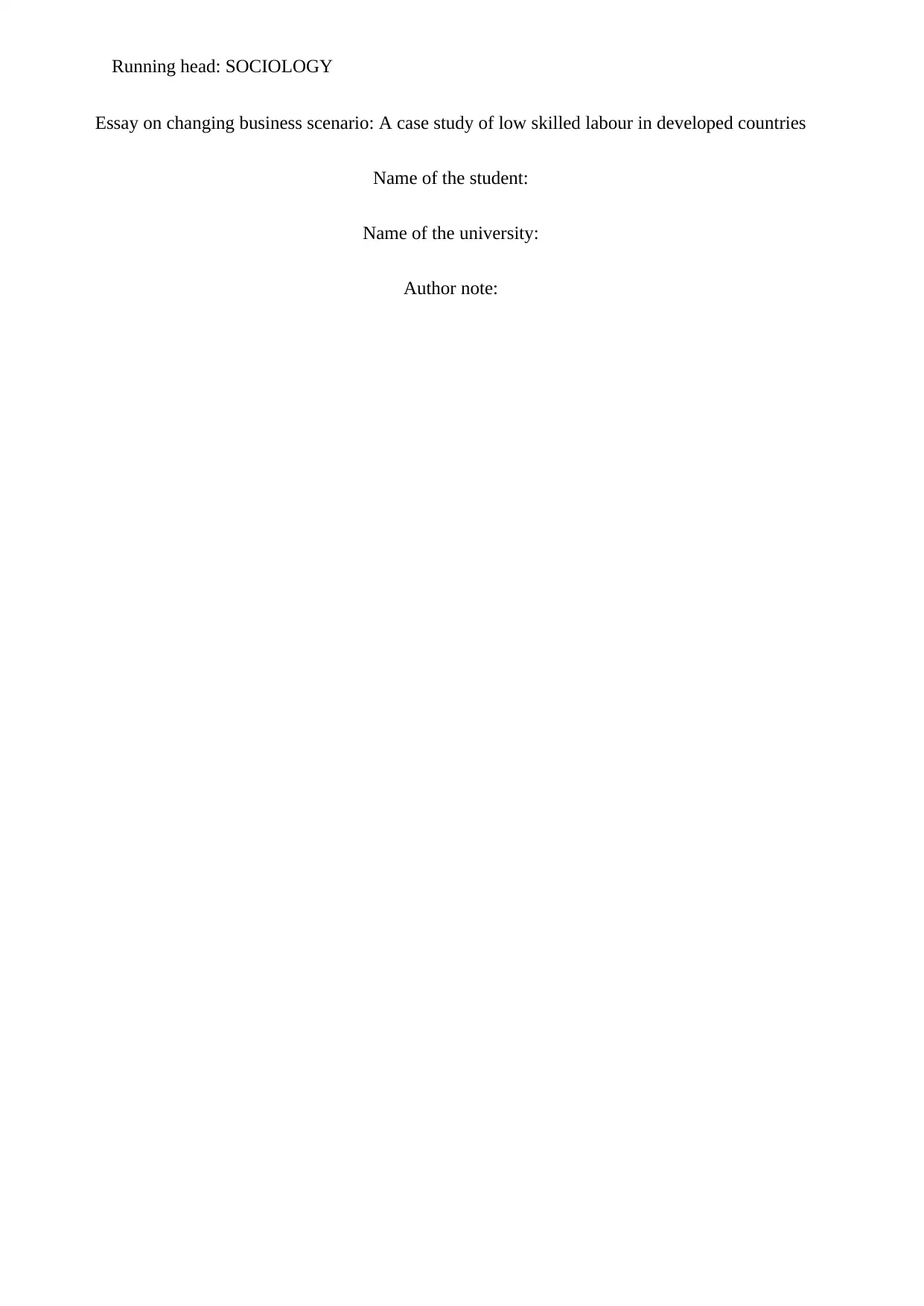
Running head: SOCIOLOGY
Essay on changing business scenario: A case study of low skilled labour in developed countries
Name of the student:
Name of the university:
Author note:
Essay on changing business scenario: A case study of low skilled labour in developed countries
Name of the student:
Name of the university:
Author note:
Paraphrase This Document
Need a fresh take? Get an instant paraphrase of this document with our AI Paraphraser
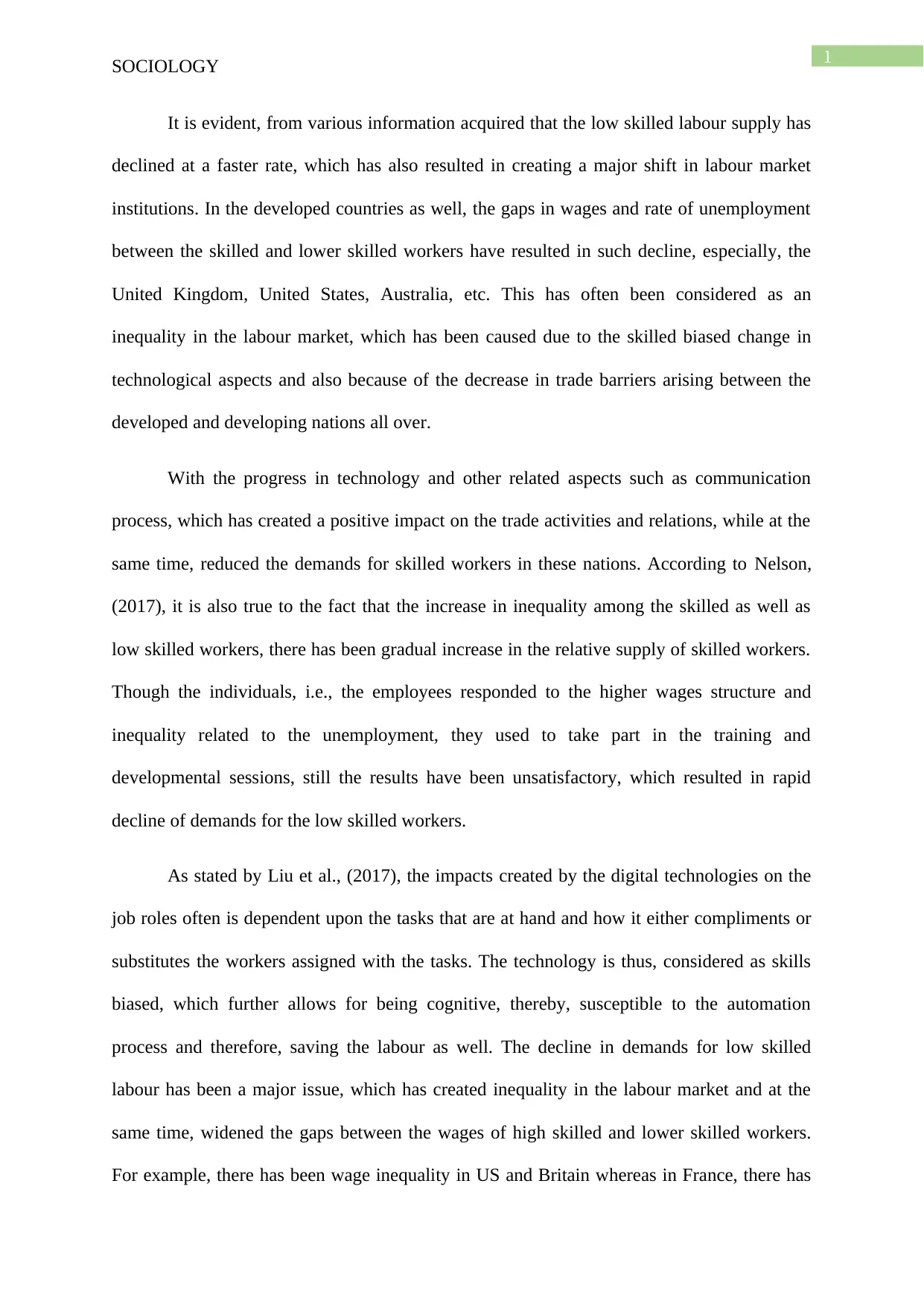
1
SOCIOLOGY
It is evident, from various information acquired that the low skilled labour supply has
declined at a faster rate, which has also resulted in creating a major shift in labour market
institutions. In the developed countries as well, the gaps in wages and rate of unemployment
between the skilled and lower skilled workers have resulted in such decline, especially, the
United Kingdom, United States, Australia, etc. This has often been considered as an
inequality in the labour market, which has been caused due to the skilled biased change in
technological aspects and also because of the decrease in trade barriers arising between the
developed and developing nations all over.
With the progress in technology and other related aspects such as communication
process, which has created a positive impact on the trade activities and relations, while at the
same time, reduced the demands for skilled workers in these nations. According to Nelson,
(2017), it is also true to the fact that the increase in inequality among the skilled as well as
low skilled workers, there has been gradual increase in the relative supply of skilled workers.
Though the individuals, i.e., the employees responded to the higher wages structure and
inequality related to the unemployment, they used to take part in the training and
developmental sessions, still the results have been unsatisfactory, which resulted in rapid
decline of demands for the low skilled workers.
As stated by Liu et al., (2017), the impacts created by the digital technologies on the
job roles often is dependent upon the tasks that are at hand and how it either compliments or
substitutes the workers assigned with the tasks. The technology is thus, considered as skills
biased, which further allows for being cognitive, thereby, susceptible to the automation
process and therefore, saving the labour as well. The decline in demands for low skilled
labour has been a major issue, which has created inequality in the labour market and at the
same time, widened the gaps between the wages of high skilled and lower skilled workers.
For example, there has been wage inequality in US and Britain whereas in France, there has
SOCIOLOGY
It is evident, from various information acquired that the low skilled labour supply has
declined at a faster rate, which has also resulted in creating a major shift in labour market
institutions. In the developed countries as well, the gaps in wages and rate of unemployment
between the skilled and lower skilled workers have resulted in such decline, especially, the
United Kingdom, United States, Australia, etc. This has often been considered as an
inequality in the labour market, which has been caused due to the skilled biased change in
technological aspects and also because of the decrease in trade barriers arising between the
developed and developing nations all over.
With the progress in technology and other related aspects such as communication
process, which has created a positive impact on the trade activities and relations, while at the
same time, reduced the demands for skilled workers in these nations. According to Nelson,
(2017), it is also true to the fact that the increase in inequality among the skilled as well as
low skilled workers, there has been gradual increase in the relative supply of skilled workers.
Though the individuals, i.e., the employees responded to the higher wages structure and
inequality related to the unemployment, they used to take part in the training and
developmental sessions, still the results have been unsatisfactory, which resulted in rapid
decline of demands for the low skilled workers.
As stated by Liu et al., (2017), the impacts created by the digital technologies on the
job roles often is dependent upon the tasks that are at hand and how it either compliments or
substitutes the workers assigned with the tasks. The technology is thus, considered as skills
biased, which further allows for being cognitive, thereby, susceptible to the automation
process and therefore, saving the labour as well. The decline in demands for low skilled
labour has been a major issue, which has created inequality in the labour market and at the
same time, widened the gaps between the wages of high skilled and lower skilled workers.
For example, there has been wage inequality in US and Britain whereas in France, there has
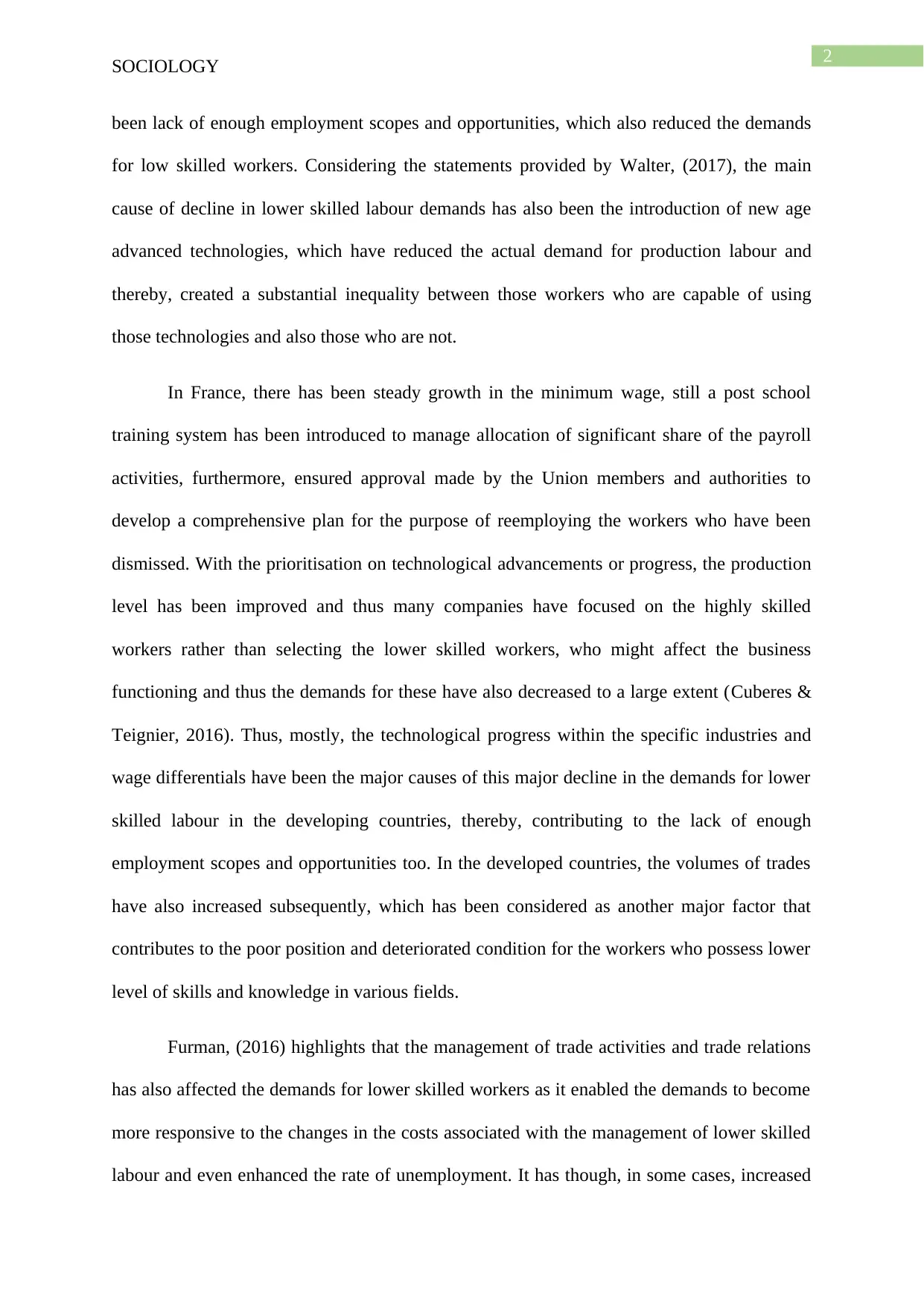
2
SOCIOLOGY
been lack of enough employment scopes and opportunities, which also reduced the demands
for low skilled workers. Considering the statements provided by Walter, (2017), the main
cause of decline in lower skilled labour demands has also been the introduction of new age
advanced technologies, which have reduced the actual demand for production labour and
thereby, created a substantial inequality between those workers who are capable of using
those technologies and also those who are not.
In France, there has been steady growth in the minimum wage, still a post school
training system has been introduced to manage allocation of significant share of the payroll
activities, furthermore, ensured approval made by the Union members and authorities to
develop a comprehensive plan for the purpose of reemploying the workers who have been
dismissed. With the prioritisation on technological advancements or progress, the production
level has been improved and thus many companies have focused on the highly skilled
workers rather than selecting the lower skilled workers, who might affect the business
functioning and thus the demands for these have also decreased to a large extent (Cuberes &
Teignier, 2016). Thus, mostly, the technological progress within the specific industries and
wage differentials have been the major causes of this major decline in the demands for lower
skilled labour in the developing countries, thereby, contributing to the lack of enough
employment scopes and opportunities too. In the developed countries, the volumes of trades
have also increased subsequently, which has been considered as another major factor that
contributes to the poor position and deteriorated condition for the workers who possess lower
level of skills and knowledge in various fields.
Furman, (2016) highlights that the management of trade activities and trade relations
has also affected the demands for lower skilled workers as it enabled the demands to become
more responsive to the changes in the costs associated with the management of lower skilled
labour and even enhanced the rate of unemployment. It has though, in some cases, increased
SOCIOLOGY
been lack of enough employment scopes and opportunities, which also reduced the demands
for low skilled workers. Considering the statements provided by Walter, (2017), the main
cause of decline in lower skilled labour demands has also been the introduction of new age
advanced technologies, which have reduced the actual demand for production labour and
thereby, created a substantial inequality between those workers who are capable of using
those technologies and also those who are not.
In France, there has been steady growth in the minimum wage, still a post school
training system has been introduced to manage allocation of significant share of the payroll
activities, furthermore, ensured approval made by the Union members and authorities to
develop a comprehensive plan for the purpose of reemploying the workers who have been
dismissed. With the prioritisation on technological advancements or progress, the production
level has been improved and thus many companies have focused on the highly skilled
workers rather than selecting the lower skilled workers, who might affect the business
functioning and thus the demands for these have also decreased to a large extent (Cuberes &
Teignier, 2016). Thus, mostly, the technological progress within the specific industries and
wage differentials have been the major causes of this major decline in the demands for lower
skilled labour in the developing countries, thereby, contributing to the lack of enough
employment scopes and opportunities too. In the developed countries, the volumes of trades
have also increased subsequently, which has been considered as another major factor that
contributes to the poor position and deteriorated condition for the workers who possess lower
level of skills and knowledge in various fields.
Furman, (2016) highlights that the management of trade activities and trade relations
has also affected the demands for lower skilled workers as it enabled the demands to become
more responsive to the changes in the costs associated with the management of lower skilled
labour and even enhanced the rate of unemployment. It has though, in some cases, increased
⊘ This is a preview!⊘
Do you want full access?
Subscribe today to unlock all pages.

Trusted by 1+ million students worldwide
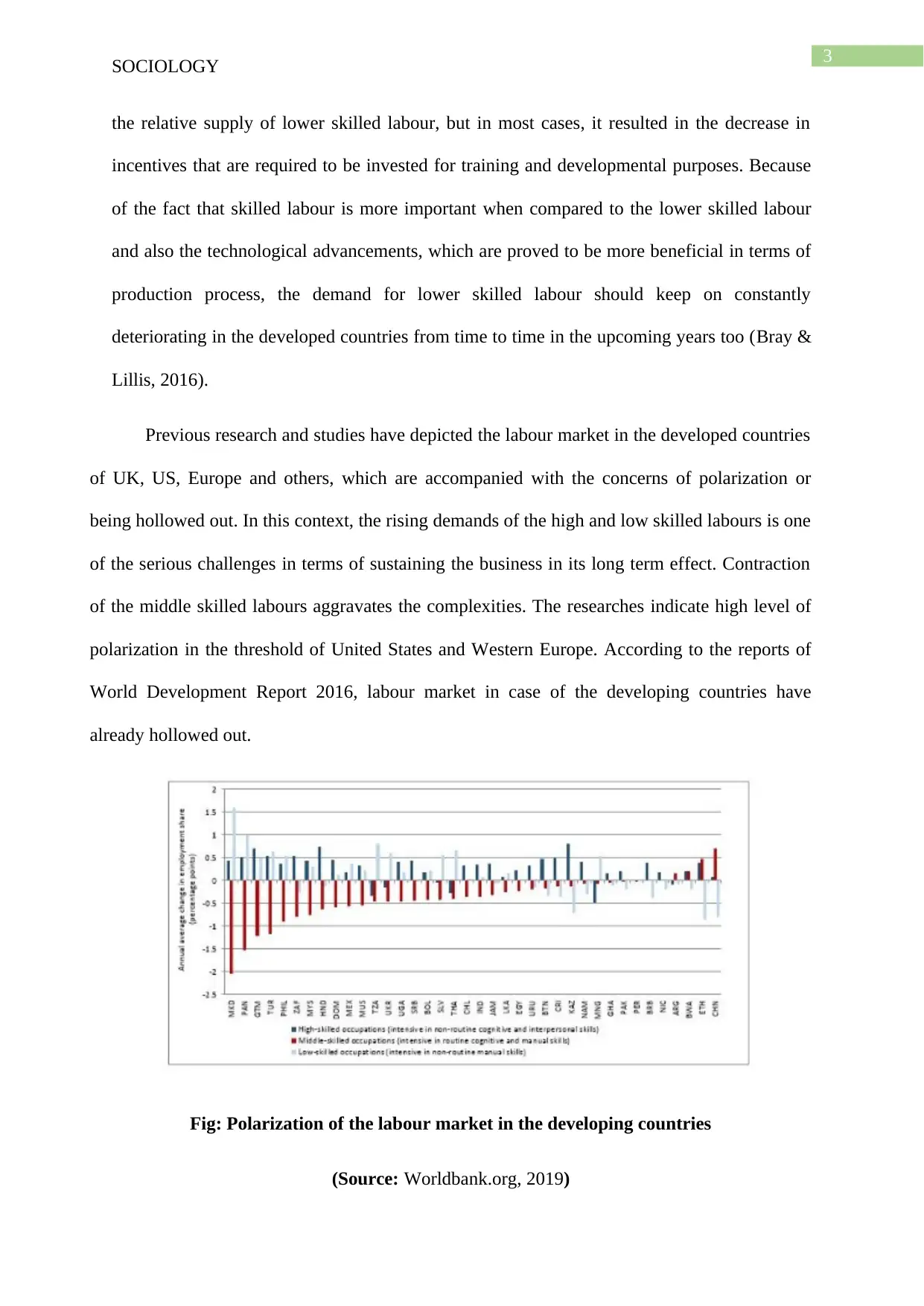
3
SOCIOLOGY
the relative supply of lower skilled labour, but in most cases, it resulted in the decrease in
incentives that are required to be invested for training and developmental purposes. Because
of the fact that skilled labour is more important when compared to the lower skilled labour
and also the technological advancements, which are proved to be more beneficial in terms of
production process, the demand for lower skilled labour should keep on constantly
deteriorating in the developed countries from time to time in the upcoming years too (Bray &
Lillis, 2016).
Previous research and studies have depicted the labour market in the developed countries
of UK, US, Europe and others, which are accompanied with the concerns of polarization or
being hollowed out. In this context, the rising demands of the high and low skilled labours is one
of the serious challenges in terms of sustaining the business in its long term effect. Contraction
of the middle skilled labours aggravates the complexities. The researches indicate high level of
polarization in the threshold of United States and Western Europe. According to the reports of
World Development Report 2016, labour market in case of the developing countries have
already hollowed out.
Fig: Polarization of the labour market in the developing countries
(Source: Worldbank.org, 2019)
SOCIOLOGY
the relative supply of lower skilled labour, but in most cases, it resulted in the decrease in
incentives that are required to be invested for training and developmental purposes. Because
of the fact that skilled labour is more important when compared to the lower skilled labour
and also the technological advancements, which are proved to be more beneficial in terms of
production process, the demand for lower skilled labour should keep on constantly
deteriorating in the developed countries from time to time in the upcoming years too (Bray &
Lillis, 2016).
Previous research and studies have depicted the labour market in the developed countries
of UK, US, Europe and others, which are accompanied with the concerns of polarization or
being hollowed out. In this context, the rising demands of the high and low skilled labours is one
of the serious challenges in terms of sustaining the business in its long term effect. Contraction
of the middle skilled labours aggravates the complexities. The researches indicate high level of
polarization in the threshold of United States and Western Europe. According to the reports of
World Development Report 2016, labour market in case of the developing countries have
already hollowed out.
Fig: Polarization of the labour market in the developing countries
(Source: Worldbank.org, 2019)
Paraphrase This Document
Need a fresh take? Get an instant paraphrase of this document with our AI Paraphraser
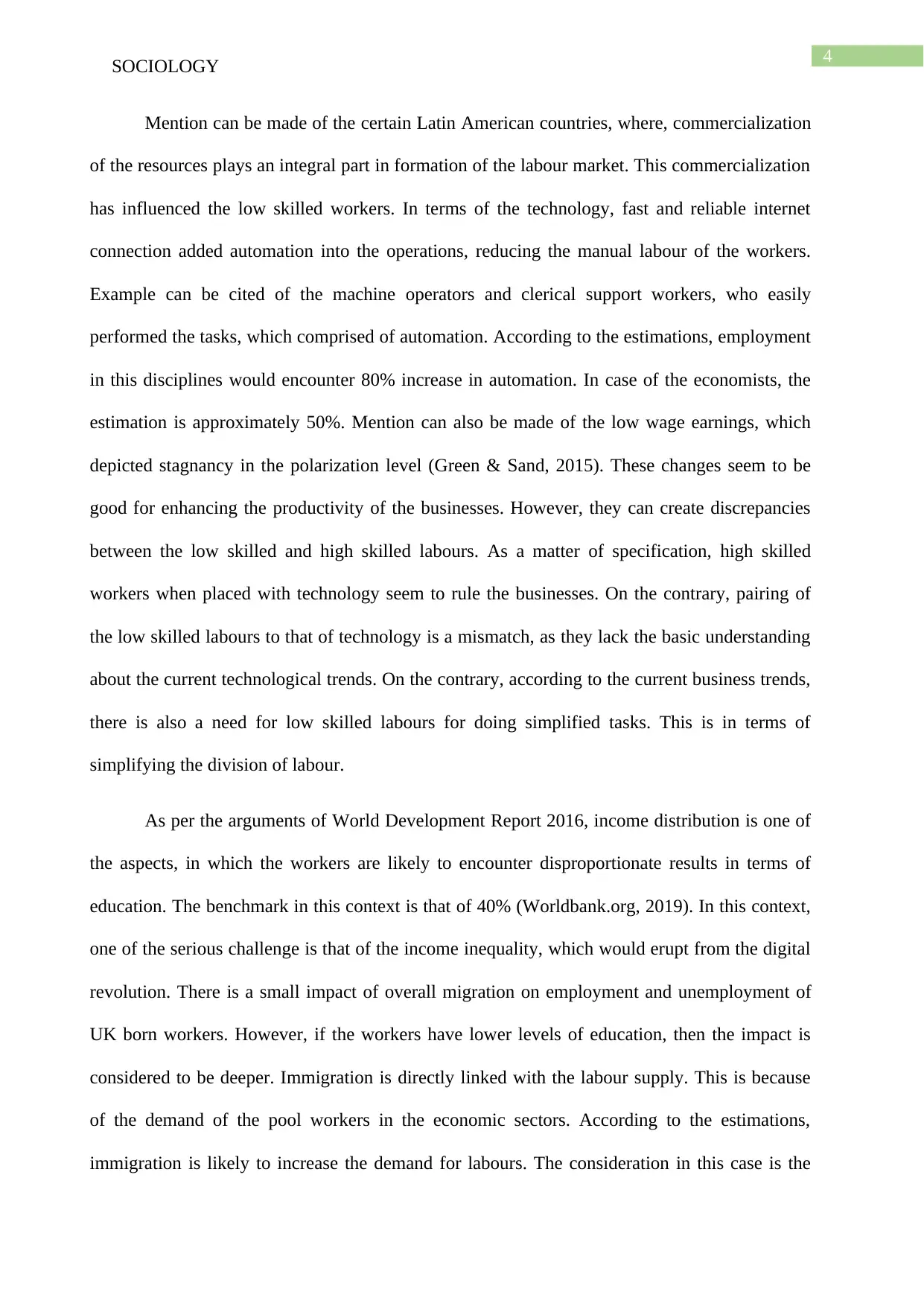
4
SOCIOLOGY
Mention can be made of the certain Latin American countries, where, commercialization
of the resources plays an integral part in formation of the labour market. This commercialization
has influenced the low skilled workers. In terms of the technology, fast and reliable internet
connection added automation into the operations, reducing the manual labour of the workers.
Example can be cited of the machine operators and clerical support workers, who easily
performed the tasks, which comprised of automation. According to the estimations, employment
in this disciplines would encounter 80% increase in automation. In case of the economists, the
estimation is approximately 50%. Mention can also be made of the low wage earnings, which
depicted stagnancy in the polarization level (Green & Sand, 2015). These changes seem to be
good for enhancing the productivity of the businesses. However, they can create discrepancies
between the low skilled and high skilled labours. As a matter of specification, high skilled
workers when placed with technology seem to rule the businesses. On the contrary, pairing of
the low skilled labours to that of technology is a mismatch, as they lack the basic understanding
about the current technological trends. On the contrary, according to the current business trends,
there is also a need for low skilled labours for doing simplified tasks. This is in terms of
simplifying the division of labour.
As per the arguments of World Development Report 2016, income distribution is one of
the aspects, in which the workers are likely to encounter disproportionate results in terms of
education. The benchmark in this context is that of 40% (Worldbank.org, 2019). In this context,
one of the serious challenge is that of the income inequality, which would erupt from the digital
revolution. There is a small impact of overall migration on employment and unemployment of
UK born workers. However, if the workers have lower levels of education, then the impact is
considered to be deeper. Immigration is directly linked with the labour supply. This is because
of the demand of the pool workers in the economic sectors. According to the estimations,
immigration is likely to increase the demand for labours. The consideration in this case is the
SOCIOLOGY
Mention can be made of the certain Latin American countries, where, commercialization
of the resources plays an integral part in formation of the labour market. This commercialization
has influenced the low skilled workers. In terms of the technology, fast and reliable internet
connection added automation into the operations, reducing the manual labour of the workers.
Example can be cited of the machine operators and clerical support workers, who easily
performed the tasks, which comprised of automation. According to the estimations, employment
in this disciplines would encounter 80% increase in automation. In case of the economists, the
estimation is approximately 50%. Mention can also be made of the low wage earnings, which
depicted stagnancy in the polarization level (Green & Sand, 2015). These changes seem to be
good for enhancing the productivity of the businesses. However, they can create discrepancies
between the low skilled and high skilled labours. As a matter of specification, high skilled
workers when placed with technology seem to rule the businesses. On the contrary, pairing of
the low skilled labours to that of technology is a mismatch, as they lack the basic understanding
about the current technological trends. On the contrary, according to the current business trends,
there is also a need for low skilled labours for doing simplified tasks. This is in terms of
simplifying the division of labour.
As per the arguments of World Development Report 2016, income distribution is one of
the aspects, in which the workers are likely to encounter disproportionate results in terms of
education. The benchmark in this context is that of 40% (Worldbank.org, 2019). In this context,
one of the serious challenge is that of the income inequality, which would erupt from the digital
revolution. There is a small impact of overall migration on employment and unemployment of
UK born workers. However, if the workers have lower levels of education, then the impact is
considered to be deeper. Immigration is directly linked with the labour supply. This is because
of the demand of the pool workers in the economic sectors. According to the estimations,
immigration is likely to increase the demand for labours. The consideration in this case is the
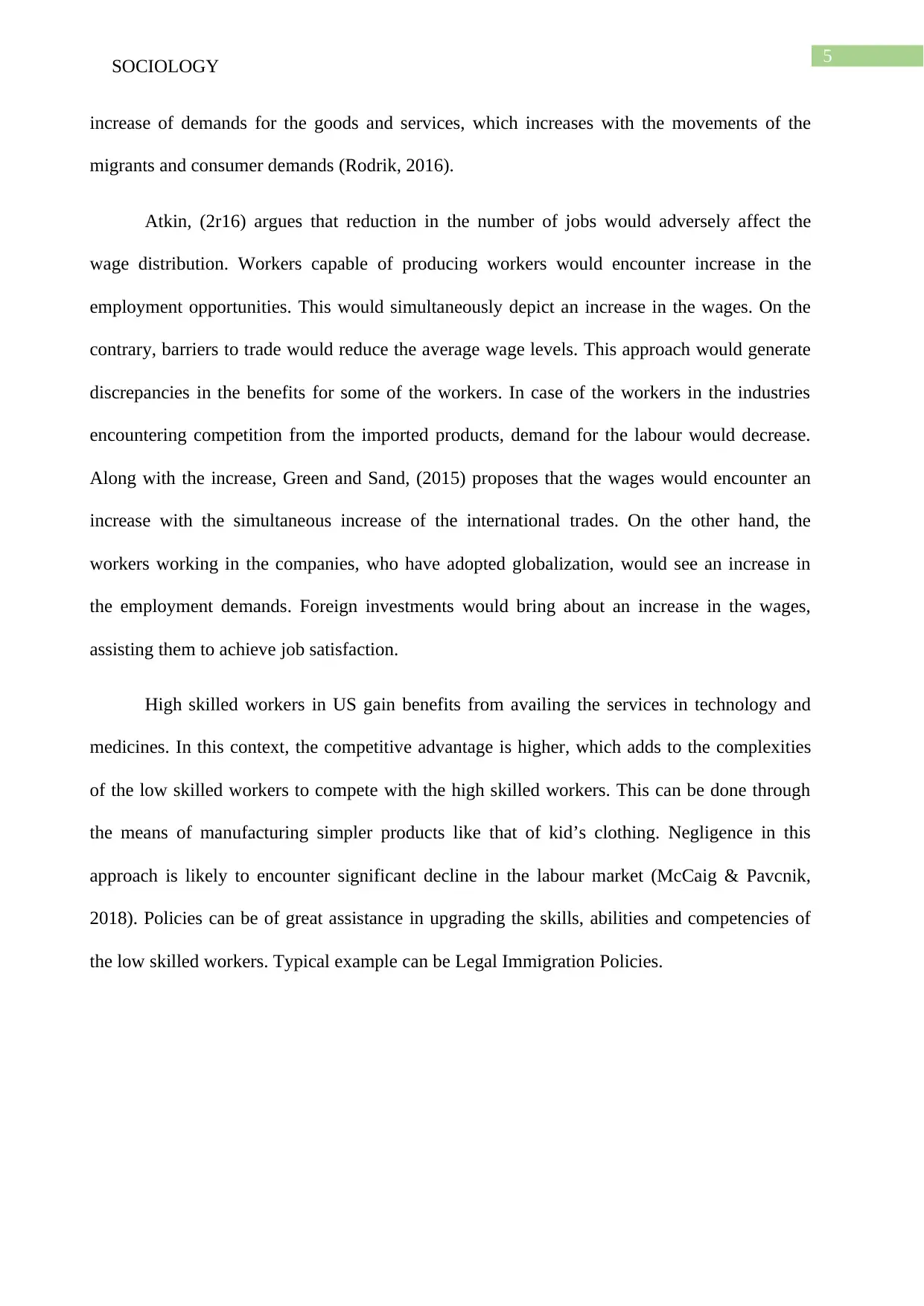
5
SOCIOLOGY
increase of demands for the goods and services, which increases with the movements of the
migrants and consumer demands (Rodrik, 2016).
Atkin, (2r16) argues that reduction in the number of jobs would adversely affect the
wage distribution. Workers capable of producing workers would encounter increase in the
employment opportunities. This would simultaneously depict an increase in the wages. On the
contrary, barriers to trade would reduce the average wage levels. This approach would generate
discrepancies in the benefits for some of the workers. In case of the workers in the industries
encountering competition from the imported products, demand for the labour would decrease.
Along with the increase, Green and Sand, (2015) proposes that the wages would encounter an
increase with the simultaneous increase of the international trades. On the other hand, the
workers working in the companies, who have adopted globalization, would see an increase in
the employment demands. Foreign investments would bring about an increase in the wages,
assisting them to achieve job satisfaction.
High skilled workers in US gain benefits from availing the services in technology and
medicines. In this context, the competitive advantage is higher, which adds to the complexities
of the low skilled workers to compete with the high skilled workers. This can be done through
the means of manufacturing simpler products like that of kid’s clothing. Negligence in this
approach is likely to encounter significant decline in the labour market (McCaig & Pavcnik,
2018). Policies can be of great assistance in upgrading the skills, abilities and competencies of
the low skilled workers. Typical example can be Legal Immigration Policies.
SOCIOLOGY
increase of demands for the goods and services, which increases with the movements of the
migrants and consumer demands (Rodrik, 2016).
Atkin, (2r16) argues that reduction in the number of jobs would adversely affect the
wage distribution. Workers capable of producing workers would encounter increase in the
employment opportunities. This would simultaneously depict an increase in the wages. On the
contrary, barriers to trade would reduce the average wage levels. This approach would generate
discrepancies in the benefits for some of the workers. In case of the workers in the industries
encountering competition from the imported products, demand for the labour would decrease.
Along with the increase, Green and Sand, (2015) proposes that the wages would encounter an
increase with the simultaneous increase of the international trades. On the other hand, the
workers working in the companies, who have adopted globalization, would see an increase in
the employment demands. Foreign investments would bring about an increase in the wages,
assisting them to achieve job satisfaction.
High skilled workers in US gain benefits from availing the services in technology and
medicines. In this context, the competitive advantage is higher, which adds to the complexities
of the low skilled workers to compete with the high skilled workers. This can be done through
the means of manufacturing simpler products like that of kid’s clothing. Negligence in this
approach is likely to encounter significant decline in the labour market (McCaig & Pavcnik,
2018). Policies can be of great assistance in upgrading the skills, abilities and competencies of
the low skilled workers. Typical example can be Legal Immigration Policies.
⊘ This is a preview!⊘
Do you want full access?
Subscribe today to unlock all pages.

Trusted by 1+ million students worldwide
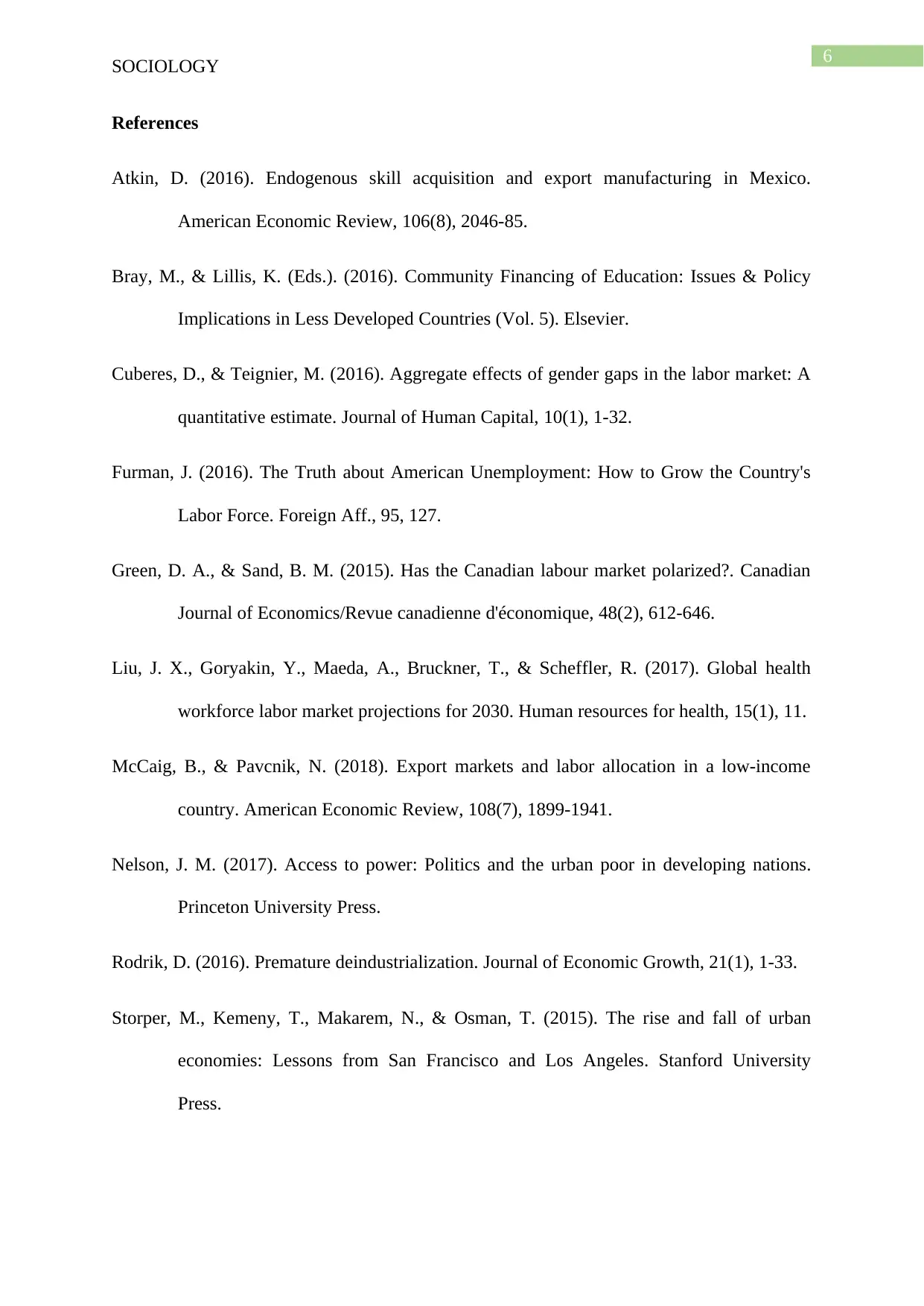
6
SOCIOLOGY
References
Atkin, D. (2016). Endogenous skill acquisition and export manufacturing in Mexico.
American Economic Review, 106(8), 2046-85.
Bray, M., & Lillis, K. (Eds.). (2016). Community Financing of Education: Issues & Policy
Implications in Less Developed Countries (Vol. 5). Elsevier.
Cuberes, D., & Teignier, M. (2016). Aggregate effects of gender gaps in the labor market: A
quantitative estimate. Journal of Human Capital, 10(1), 1-32.
Furman, J. (2016). The Truth about American Unemployment: How to Grow the Country's
Labor Force. Foreign Aff., 95, 127.
Green, D. A., & Sand, B. M. (2015). Has the Canadian labour market polarized?. Canadian
Journal of Economics/Revue canadienne d'économique, 48(2), 612-646.
Liu, J. X., Goryakin, Y., Maeda, A., Bruckner, T., & Scheffler, R. (2017). Global health
workforce labor market projections for 2030. Human resources for health, 15(1), 11.
McCaig, B., & Pavcnik, N. (2018). Export markets and labor allocation in a low-income
country. American Economic Review, 108(7), 1899-1941.
Nelson, J. M. (2017). Access to power: Politics and the urban poor in developing nations.
Princeton University Press.
Rodrik, D. (2016). Premature deindustrialization. Journal of Economic Growth, 21(1), 1-33.
Storper, M., Kemeny, T., Makarem, N., & Osman, T. (2015). The rise and fall of urban
economies: Lessons from San Francisco and Los Angeles. Stanford University
Press.
SOCIOLOGY
References
Atkin, D. (2016). Endogenous skill acquisition and export manufacturing in Mexico.
American Economic Review, 106(8), 2046-85.
Bray, M., & Lillis, K. (Eds.). (2016). Community Financing of Education: Issues & Policy
Implications in Less Developed Countries (Vol. 5). Elsevier.
Cuberes, D., & Teignier, M. (2016). Aggregate effects of gender gaps in the labor market: A
quantitative estimate. Journal of Human Capital, 10(1), 1-32.
Furman, J. (2016). The Truth about American Unemployment: How to Grow the Country's
Labor Force. Foreign Aff., 95, 127.
Green, D. A., & Sand, B. M. (2015). Has the Canadian labour market polarized?. Canadian
Journal of Economics/Revue canadienne d'économique, 48(2), 612-646.
Liu, J. X., Goryakin, Y., Maeda, A., Bruckner, T., & Scheffler, R. (2017). Global health
workforce labor market projections for 2030. Human resources for health, 15(1), 11.
McCaig, B., & Pavcnik, N. (2018). Export markets and labor allocation in a low-income
country. American Economic Review, 108(7), 1899-1941.
Nelson, J. M. (2017). Access to power: Politics and the urban poor in developing nations.
Princeton University Press.
Rodrik, D. (2016). Premature deindustrialization. Journal of Economic Growth, 21(1), 1-33.
Storper, M., Kemeny, T., Makarem, N., & Osman, T. (2015). The rise and fall of urban
economies: Lessons from San Francisco and Los Angeles. Stanford University
Press.
Paraphrase This Document
Need a fresh take? Get an instant paraphrase of this document with our AI Paraphraser
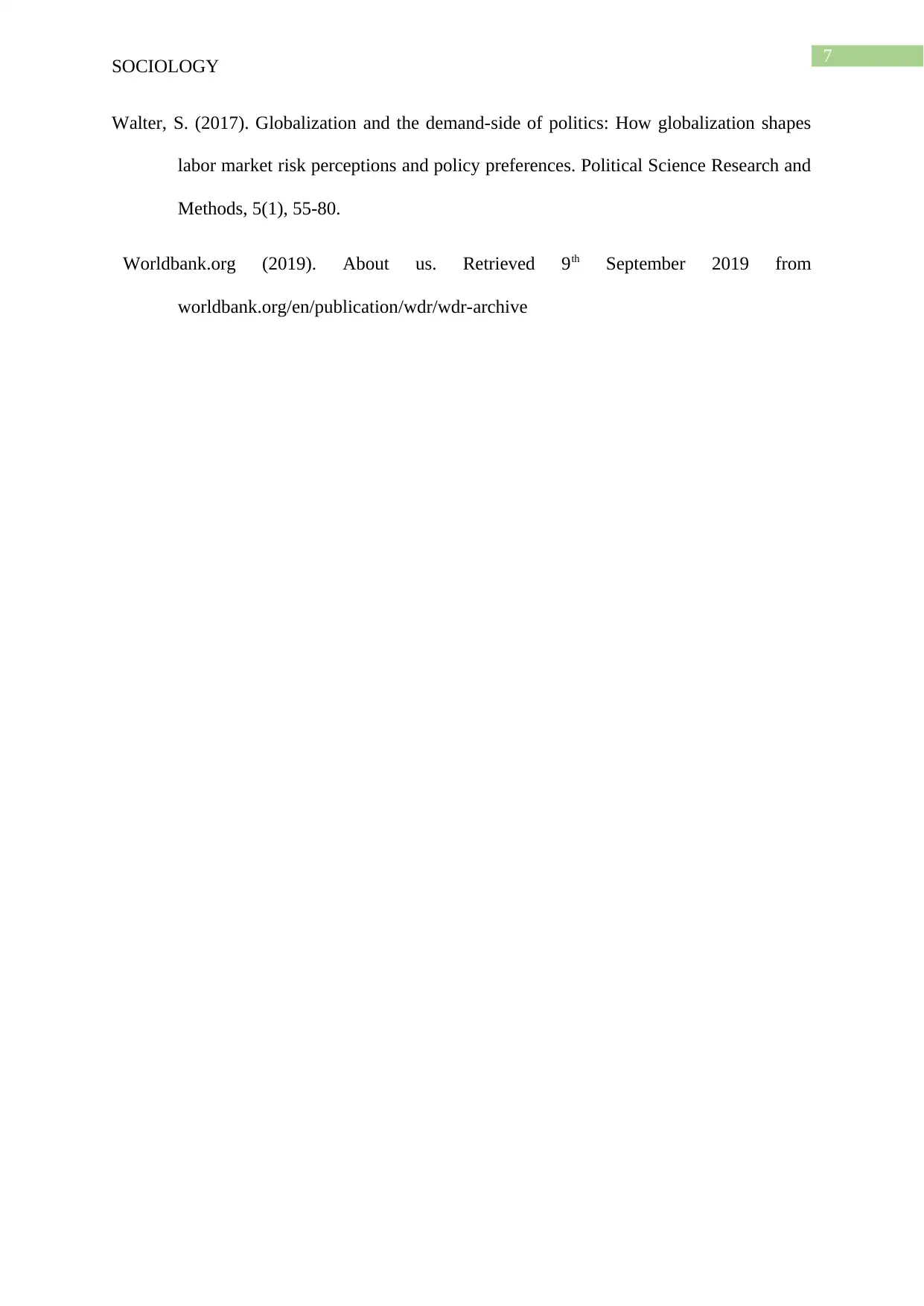
7
SOCIOLOGY
Walter, S. (2017). Globalization and the demand-side of politics: How globalization shapes
labor market risk perceptions and policy preferences. Political Science Research and
Methods, 5(1), 55-80.
Worldbank.org (2019). About us. Retrieved 9th September 2019 from
worldbank.org/en/publication/wdr/wdr-archive
SOCIOLOGY
Walter, S. (2017). Globalization and the demand-side of politics: How globalization shapes
labor market risk perceptions and policy preferences. Political Science Research and
Methods, 5(1), 55-80.
Worldbank.org (2019). About us. Retrieved 9th September 2019 from
worldbank.org/en/publication/wdr/wdr-archive
1 out of 8
Related Documents
Your All-in-One AI-Powered Toolkit for Academic Success.
+13062052269
info@desklib.com
Available 24*7 on WhatsApp / Email
![[object Object]](/_next/static/media/star-bottom.7253800d.svg)
Unlock your academic potential
Copyright © 2020–2025 A2Z Services. All Rights Reserved. Developed and managed by ZUCOL.





